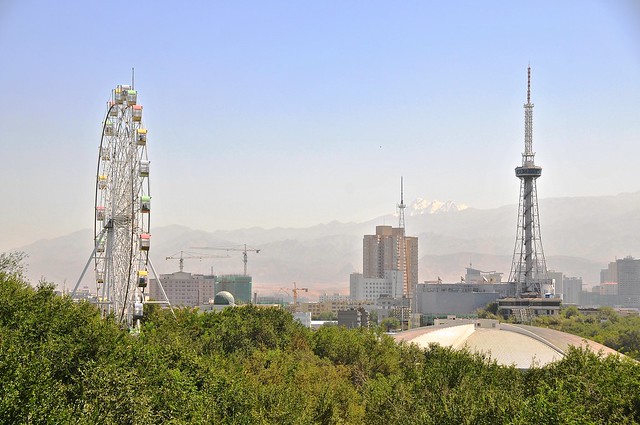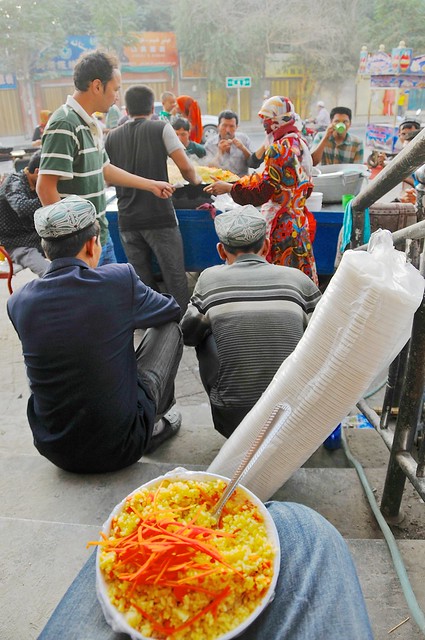Urumqi offers little for the traveler. Its a large and relatively anonymous Han-dominated Chinese city, full of modern buildings. Although there is a substantial Uyghur population, traditional Uyghers live in what are effectively ghettos, under the careful watch of Chinese security forces. Much of the security is in response to Uyghur-Han tensions and isolated Uyghur acts of violence.
As a whole, Xinjiang is 43% Uyghur and 41% Han, with the Han proportion growing as a result of governmental efforts to encourage migration (including, reportedly, granting prisoners early release conditional on them moving there): as in Tibet and Inner Mongolia, the two other autonomous regions in China, they're trying to marginalize the indigenous ethnic populations by flooding their territory with Han. In 1945, for example, Xinjiang was just 6% Han and 83% Uyghur.
On the other hand, Urumqi—the capital city of Xinjiang and its economic powerhouse—is about 75% Han and 13% Uyghur. Although Urumqi has been a Han city for a long time, the major difference is that it's now a city of over 3 million people, while in 1949 it had only 100,000 people (of which 62% were
Han).
| Year | Total | Uyghur | %Uyghur | Han | %Han |
| 1949 | 100,710 | 18,310 | 16.99 | 67,588 | 62.29 |
| 1950 | 121,746 | 21,074 | 17.30 | 77,554 | 63.70 |
| 1951 | 125,275 | 21,955 | 17.52 | 78,902 | 62.98 |
| 1955 | 171,897 | 31,769 | 18.48 | 109,842 | 63.89 |
| 1960 | 634,844 | 76,496 | 12.04 | 477,321 | 75.18 |
| 1965 | 615,189 | 62,439 | 10.14 | 463,804 | 75.39 |
| 1968 | 679,165 | 72,339 | 10.65 | 511,547 | 75.31 |
| 1972 | 765,788 | 73,265 | 9.56 | 587,813 | 76.75 |
| 1975 | 930,430 | 91,708 | 9.85 | 716,550 | 77.01 |
| 1980 | 1,060,502 | 108,239 | 10.20 | 812,557 | 76.62 |
| 1985 | 1,172,335 | 138,546 | 11.81 | 868,789 | 74.10 |
| 1990 | 1,384,300 | 173,200 | 12.51 | 1,007,355 | 73.30 |
| 1996 | 1,478,922 | 188,327 | 12.73 | 1,076,319 | 72.77 |
| 2000 | 2,081,834 | 266,475 | 12.80 | 1,567,621 | 75.30 |
Urumqi is the capital city of Xinjiang, and in many ways it's a pretty good representation of what the government wants to turn Xinjiang into: predominantly Han, visually similar to other bland, large cities in China, with materialistic Han culture as dominant, and with minorities relegated to what are functionally ghettoes, and doing all this while maintaining sanitized versions of minority culture as tourist attractions for the Han. The Uyghur are well aware of what the government has done in Inner Mongolia and Tibet, and are aware that their culture and way of life are under threat, and in many ways Urumqi has become ground zero in the battle for Xinjiang—although there have been tensions and incidents throughout Xinjiang, and even in
Kunming and
Beijing, Urumqi remains the most identifiable source of ongoing tension.
Obviously, the pivotal incident in the recent history of these tensions is the
2009 Urumqi riots, which themselves were a response to an incident in eastern China in which
Uyghur workers were killed after false rumors circulated that Uyghurs had raped a Han woman.
Whatever the genesis of the recent tensions, it seems clear to me that the Uyghur have learned from the experience of Tibet and seen how ineffective the Tibetan passive resistance and self-immolation has been, and instead adopted a more aggressive approach. Instead of punishing themselves as a way of drawing attention to their disagreement and unhappiness with Han domination, the Uyghur instead have acted in a way to make the Han feel unwelcome and unsafe in Xinjiang. This seems to have had the desired effect: while Tibet has been overrun with Han migrants and tourists (so much so that even some Han will admit there are too many tourists), Xinjiang enjoys a reputation among the Han as being too dangerous to visit and a relatively unattractive migration destination.
To the extent that the Uyghur really don't want Han in their homeland—even as tourists—I think that the Western media gets a lot of the story wrong. A recent
NY Times article, for example, lamented the decline in tourism in Xinjiang as though this was a blow to people living in Xinjiang, and not an actual goal of not only the terrorists but of many Uyghurs. (Also, it seems as if any English-language article on Xinjiang must describe it as 'restive.') A drop in tourism is unlikely to affect that many Uyghurs, especially since it seems like most travel agencies, hotels, etc., are run by Han, and not Uyghurs. This extends everywhere, from the big travel agents to hotels, and even to hostels (typically run by young Han migrants, even if they do tend to be very sympathetic to the Uyghur). The Han dominance in this industry merely reflects Han dominance of all lucrative industry: even though Uyghur benefit from quotas that make it easier to attend university (and are exempt from the one-child policy), almost all jobs seem to be filled by Han, and most Uyghur seem to work in the traditional farming and animal husbandry sector, while it's Han migrants who are employed in newer industrial projects.
The government response to the threat of Uyghur terrorism is to institute a police state. There are license plate cameras everywhere, including on highways in the middle of nowhere. Police checkpoints where they scan the RFID micro-chip equipped ID cards of all passengers are also common, and are located between major cities. The government keeps track of where everyone is, at all time, where they stay (you scan your ID card when checking in at a hotel, just as you do when purchasing a train or bus ticket), and what you're looking at on the internet (you scan your ID card at internet cafes and you need a government permit in order to have an open internet hotspot). Indeed, for almost a year after the 2009 riots the government totally disabled the internet in Urumqi: no one could access anything more than about 100 local sites. Luggage must be X-rayed when taking both the train and bus. Gas stations are barricaded and all passengers must get out before the barricades are lifted and cars allowed onto the premises. Security guards in riot gear patrol potential flashpoints. The fear and paranoia is palpable.
 |
| Pagoda on the western edge of Hong Shan (Red Rock) park. Unsurprisingly, all of the parks are Han style. You can see lots of tourists taking pictures by the pagoda, which is the highest point in the park and city centre. I saw a Uyghur man stand in front of a Han Chinese family so their picture couldn't be taken, then pretend not to understand Mandarin when they rather politely asked him to move. |
 |
| Chinese signs of this nature are often quite poetic, but I wonder about their efficacy since empathy doesn't seem to be a Han strength. |
 |
| Looking southeast from Hong Shan park. Urumqi is on the northern edge of the Tian Shan mountain range that runs
from Kyrgyzstan all the way through north-central Xinjiang to the edge
of Gansu. |








